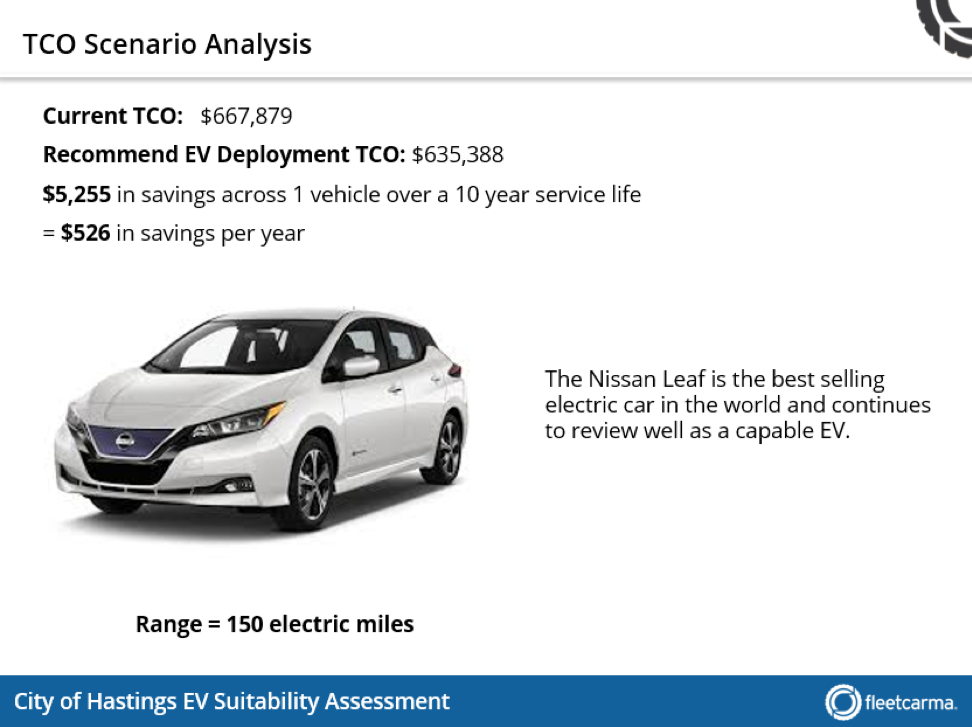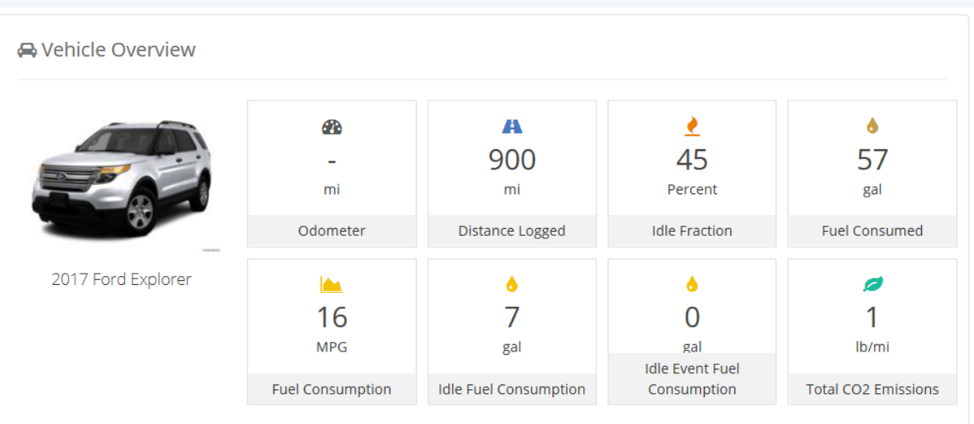How to Electrify Your Fleet: Lessons from Cities Charging Ahead Fleet Studies
September 4, 2019 | Joe Cella | Education

Stakeholder groups working to increase electric vehicle (EV) adoption often highlight the money you can save by driving an EV over the lifetime of the vehicle as one of several benefits of switching to an EV. Many studies support this finding on EV savings (such as this one from MIT) and have caught the interest of cities which manage a fleet of vehicles. Recently, Minnesota cities working together in the Cities Charging Ahead effort (more info here) saw firsthand through an analysis of their fleets just how much they could save by replacing certain vehicles in their municipal fleets with EVs.
Fleet Study 101
Through the Cities Charging Ahead effort, the Minnesota cities of Bloomington, Faribault, Fridley, Hastings, Inver Grove Heights, St. Louis Park, White Bear Lake, Winona, and Woodbury completed fleet studies funded by Xcel Energy, and Coon Rapids completed a fleet study funded by Connexus Energy. Each city worked with a company called FleetCarma to install telematic devices in chosen fleet vehicles and analyze that data. The telematics devices track a variety of vehicle usage statistics including idle time, acceleration patterns, and daily miles of any given vehicle equipped with a device. While the data was available in real-time to each of the cities during their fleet study, FleetCarma presented the city with a summary and analysis of the data gathered after a fixed amount of time (six months to a year depending on the city).
The summaries were full of interesting data on daily driving patterns, including information about how aggressively city employees were accelerating and breaking. The highlight of each report, which was especially relevant to Cities Charging Ahead, was that each city received an analysis about which of their fleet vehicles were the best fit to be replaced by EVs based on the total cost of ownership savings over the life of the vehicle. Since everything was tracked by the telematic devices (down to the last drop of fuel consumed), FleetCarma was able to calculate exactly the difference in the cost to operate and maintain an existing vehicle in each fleet compared to a hypothetical EV replacement.

Figure 1. FleetCarma results presented to the City of White Bear Lake, 2019. Note. TCO stands for Total Cost of Ownership
When making fleet purchasing decisions, numbers are hard to ignore. Having the results of a FleetCarma study on hand has equipped participating cities with clear data about the money their city could save if replacing fleet vehicles with EVs. As figure 1 shows, the City of White Bear Lake would save $322,077 by replacing 13 vehicles with EVs, which is no small change—not to mention the emissions reductions! In the short time since many of the FleetCarma studies came to an end (most wrapped up in the winter of 2018/19 or spring 2019), the Cities Charging Ahead cities have collectively added 10 EVs to the city fleets, with another 10 included in purchasing plans for 2020.

Lessons Learned
FleetCarma studies provided valuable information for these Minnesota cities to make better-informed decisions about fleet purchasing strategies. The data from these studies can help other cities make informed decisions as well. By analyzing the data, trends appear that can help other cities identify which vehicles are the best candidates to replace with EVs, based on driving patterns and characteristics. Of course, each fleet is different, and vehicles may not be used the exact same way in each department and city. That being said, there are some clear indicators that point toward the dollar, fuel, and emissions savings that are possible by going electric.
“The FleetCarma study not only showed us how to transition the city fleet to electric vehicles, but it also provided information about how we could do a better job of eco-driving and perhaps reduce the number of vehicles in our fleet.” – Dave Wanberg, City of Faribault City Planner
By analyzing data trends, we identified three key lessons when looking for vehicles to swap out:
- More miles driven=more savings
- Look for vehicles that take many short trips
- Switch vehicles that idle a lot
Lesson 1: More miles driven = more savings
The studies in Minnesota cities found that average miles driven in a day held the strongest correlation with overall dollar savings for switching to an EV. This makes sense since the two biggest reasons for the lower cost of driving an EV (compared to a traditional internal combustion engine car) are lower fuel costs and significantly lower maintenance costs (no oil changes, spark plugs, belts). Simply stated, for each mile driven in an EV vs. an internal combustion engine car, the savings rack up.
Also, every vehicle studied had an average daily usage of under 180 miles, which is well within the range of most modern battery electric vehicles. Because EVs are most commonly charged overnight and begin each day at full power, if a city employee’s day of driving does not exceed the maximum range of the vehicle, they will never have to worry about charging or refueling during the day. Even vehicles that are sometimes required to put in long days can be replaced with an EV. For example, the City of Morris recently replaced a sedan with a Chevy Volt, which can handle the all-electric miles for in-town trips and the additional range offered by the plug-in hybrid system means that employees taking longer trips (to the Twin Cities for example) can still comfortably drive electric. If a fleet vehicle is being driven each day, but rarely has days exceeding 200 miles, it is likely a perfect fit to be replaced with an EV.

Figure 2. FleetCarma results and recommendation presented to the City of Hastings, Minnesota, 2009. Note. Replacing a Chevy Cruze with a Nissan Leaf would save the City of Hastings $5,255 over the vehicle’s lifetime. With a 150-mile all-electric range and access to charging, the Leaf can handle even the longest days of driving. The Nissan Leaf+ has a range of over 200 miles, and ranges increase every year!
Lesson 2: Look for vehicles that make a lot of short trips
Another factor that provides powerful guidance to fleet decision-makers is the number of trips vs. distance of trips. A high frequency of trips paired with small average trip distance is a clear indicator of a good fit for an electric replacement. Small, short trips achieve the highest possible fuel efficiency in EVs and the savings quickly add up. This kind of driving pattern is most commonly seen in occupations that require employees to visit many different locations in the city each day, such as the work performed by someone in a permitting department. These shorter trips are generally low speed, (which maximizes battery range) and likely indicate high idle time (more on this later). With a daily workload within the 200-mile range, electric fleet vehicles performing this kind of work can be easily charged overnight, dependably perform each day, and save fuel. Finally, almost every vehicle exhibiting this kind of driving behavior in the dataset is a sedan or small hatchback. The current EV market has robust options available for smaller models, and vehicles serving in this capacity offer a perfect opportunity to add EVs to fleets and provide employees ample driving range and performance.
Lesson 3: Switch vehicles that idle a lot
The last noteworthy characteristic to identify if a fleet vehicle is a good candidate for electrification is idle time. Because EVs do not require an engine to run while they idle, they do not waste fuel by being left on. Additionally, during Minnesota winters, the vehicle interior can be kept warm at a fraction of the fuel cost of an internal combustion engine vehicle. Even with anti-idling policies in place, many cities participating in the fleet studies were shocked to see how much fuel is wasted each year by a vehicle idling. Public safety vehicles that are required to idle frequently to keep power flowing to police and fire equipment, for example, have suitable hybrid options, which rely on electric batteries and power to keep the safety equipment operational and can turn off the engine to save on fuel. Employees that prefer to leave their air conditioning or heat on or want to leave the vehicle running while making a short stop will cut their fuel cost drastically by switching to an EV.

Figure 3. FleetCarma data on a Ford Explorer used by the City of Faribault. Note. This Ford Explorer in Faribault consumed 57 gallons of fuel idling between June 2018 and December 2018, with 45% of the vehicle’s usage time being spent idle. The city would save $9,061.59 by replacing it with a Mitsubishi Outlander PHEV
Conclusion
Replacing fleet vehicles that have high daily mileage, take a lot of trips, and/or idle frequently will save cities and organizations money over the life of the vehicle. While EVs do have slightly higher upfront costs, the return on investment is high as the savings from fuel and maintenance stack up. Some vehicles in city fleets will not be suitable to be replaced with an EV at this time and the EV market is still developing truck and SUV options, although there are several exciting options on the horizon.
The general trends that have come out of the Cities Charging Ahead fleet studies are informative and useful, but each fleet is different. By applying the lessons learned through the CCA studies to your fleet, cities and organizations can save money, reduce emissions, and support achieving a decarbonized energy system.
Download How to Electrify Your Fleet: Lessons from Cities→
If you would like to explore a FleetCarma study for your city or organization, click here.
You can also sign up for the Drive Electric MN newsletter to stay up to date on all the happenings in the world of EVs in Minnesota. Finally, thank you to all of the Cities Charging Ahead cities for sharing their data and results.
Cities Charging Ahead! is led by the Great Plains Institute and Clean Energy Resource Teams (CERTs). Funding is provided through the Carolyn Foundation, Energy Foundation, and in partnership with Xcel Energy, which provides support and resources in line with the company’s long-term clean energy plan to electrify transportation.
